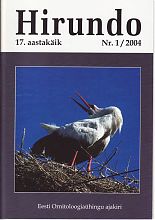Hirundo 1/2004
Lõhmus, A.
Monitoring raptors and owls in Estonia, 1999-2003: decline of the Goshawk and the Clockwork of vole-cycles
Summary: The paper is the third summary of the raptor monitoring project of the Estonian Ornithological Society (see Lõhmus 1994, 1999a for previous reports). Nesting territories (NT) of raptors and owls were mapped in 19 study plots covering a total of 1870 km2 in 1999-2003 (Fig. 1). Land cover of the plots resembled the Estonian average situation (Table 1), hence the densities of evenly distributed species can be extrapolated to the whole country (Table 2). Potential nest sites were checked in three additional areas and also outside the plots; altogether 1889 occupied nests (the rare eagle species excluded) and 1540 brood sizes were recorded (Table 3).
Altogether 22 species held territories in the plots. The average total density was 41 NT per 100 km2, five common species (Common Buzzard, Sparrowhawk, Tawny Owl, Ural Owl, Long-eared Owl) accounting for 69% of it. The rarest species – the Merlin and the Short-eared Owl – occurred in only one plot in one year.
Decline of the Goshawk was the only highly significant (P=0.004) difference between the average densities in the same plots in 1994-1998 and 1999-2003. The decline was on average 0.8±0.4 NT per 100 km2 or 34%. In ten years, the population has halved. Since also the productivity of the Goshawk has decreased, the most probable reason is the deterioration of habitats due to intensified forestry and/or abandonment of agricultural areas. There were also tendencies of decline in the Pygmy Owl (P=0.092) and of increase in the Marsh Harrier (P=0.070).
Most species had annually stable numbers, the only exception among common species being the Long-eared Owl. This species had regular three-year-period fluctuations of threefold amplitude, but the mean abundance has not changed since the late 1980s (Fig. 3). Top years of Long-eared Owl density (1990, 1993, 1996, 1999 and 2002) were good vole-years, which were also revealed in the productivities of several vole-eating species (the Common Buzzard, Lesser Spotted Eagle, Tawny, Ural and Long-eared Owls; see Fig. 4, Lõhmus 1999b and Lõhmus & Väli 2004).
Leito, A., Leito, T., Õunsaar, M. & Truu, J.
The numbers and distribution of the Eurasian Crane during autumn staging on Hiiumaa Island, and the impact of agriculture
Summary: Autumn staging of the Eurasian Crane (Grus grus) has been regularly monitored on Hiiumaa Island since 1982. The staging sites are mostly situated in the eastern and southern parts of the island. Particularly important sites are in the surroundings of Käina and Hellamaa villages (Figure 1). The main concentration areas of cranes have been stable but the relative importance of different staging sites has varied greatly between years (Table 1, Figure 2). Altogether, 960-4230 staging cranes have been censused on Hiiumaa Island in the autumns 1982-2002. The linear trend of numbers over the period suggests a decrease, though this is statistically not significant. The numbers of staging cranes depend on the structure and extent of field crop (Figure 4). We found statistically significant positive relationships between the number of cranes and the extent of winter wheat (Figure 5), winter rye and summer barley. The correlation between the crane numbers and the extent of winter wheat was strongest near Hellamaa (Figure 6). Significant negative correlations were found between the number of cranes and the extent of summer wheat and oats.
Ots, M. & Paal, U.
Rarities in Estonia 2001-2002: Report of the estonian Rarities Committee
Summary: This fourth report of the Estonian Rarities Committee covers the years 2001-2002, but some earlier records have also been included. Altogether 230 records were definitely assessed (Table 1), and 206 (90%) of these were accepted.
The records are listed in systematic order and presented chronologically. Records of birds of unclear origin, escapees from captivity, corrections and changes, records not accepted, and records formerly accepted but now rejected are listed separately from the main list of accepted records. The four numbers in brackets after species’ name (a/b – c/d) indicate (a) the total number of records before 2001, (b) the number of individuals (if possible to judge) before 2001; © the number of records in 2001-2002, (d) the number of individuals in 2001-2002. X instead of a number means unknown number of records or individuals. The details included for each record are: date(s), locality, parish (khk.), district, number of individuals (is., isend), pairs (paar), nests (pesa) etc. if more than one, sex and age (if known; a = calendar year) and names of observers. The meaning of some Estonian terms and expressions: ja = and, läh. = near, jv. = lake, s. = island, laht = bay, (tõenäoliselt) sama isend = (probably) the same individual, pesitsemine = breeding.
In 2001-2002, 5 new species in an apparently wild state (AERC category A) were added to the Estonian list: in 2001 Anas americana, Vanellus leucurus, Calidris acuminata and Lanius isabellinus, in 2002 Anthus godlewskii. At the same time, 2 species – Stercorarius skua and Luscinia megarhynchos – were excluded from the Estonian list because formerly accepted records were now rejected. In the same period, the breeding of Tringa stagnatilis and Hippolais caligata in Estonia was confirmed. Altogether, 344 species of apparently wild state or released species which have established self-supporting breeding populations in Estonia or in neighbouring countries (i.e. categories A-C) and five species of unclear origin (category D) have been recorded in Estonia by 31.12.2002.
Notes
Männik, R. & Sein, G. An Osprey nested successfully on an electricity pole in a white stork nest
Saks, L. A male Greenfinch with thirteen tail feathers
EOS chronicle and news

